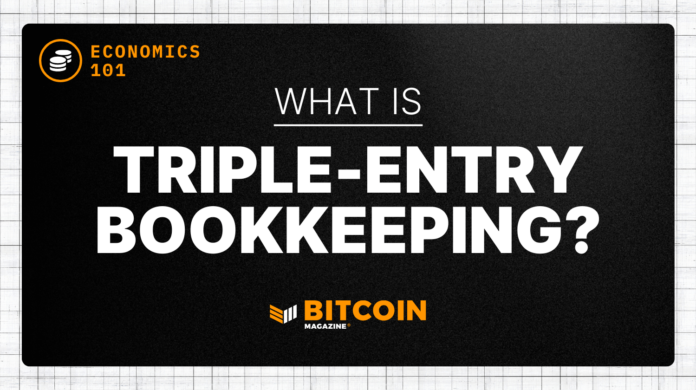The triple-entry accounting system is a concept that emerged with the advent of blockchains. This new approach to accounting has the potential to transform the way transactions are recorded and verified. In this article, we explore the history of bookkeeping, from the ancient single-entry system to the more recent double-entry system, and finally delve into how the triple-entry accounting system is evolving toward the future.
Introduction
Accounting has long been an essential part of recording financial transactions. The introduction of blockchains has brought about a paradigm shift in how accounting is perceived and practiced. The triple-entry accounting system builds upon the traditional double-entry bookkeeping method by incorporating an additional layer of transparency and security provided by blockchain technology.
With the rapid technological advancement, the traditional methods of accounting have faced numerous challenges. The reliance on centralized systems and manual record-keeping has often led to errors, fraud, and inefficiencies.
Blockchain, often referred to as a distributed ledger, is a decentralized and immutable digital ledger that records transactions across multiple computers. It offers a transparent and secure way of recording and verifying transactions, eliminating the need for intermediaries and reducing the risk of fraud.
The triple-entry accounting system takes advantage of a blockchain’s unique features to enhance the accuracy and reliability of financial records. In addition to the traditional debit and credit entries, a third entry is added to the ledger, which consists of a cryptographic signature. This signature serves as proof of the transaction’s authenticity and ensures that it cannot be tampered with (assuming the blockchain itself is tamper resistant).
The triple-entry accounting system provides a higher level of transparency and trust for financial transactions. Each transaction is recorded on the blockchain, creating an immutable audit trail that can be accessed and verified by all relevant parties. This eliminates the need for reconciliation and auditing processes, as the information is readily available and verifiable.
Furthermore, the decentralized nature of blockchain ensures that no single entity has control over the financial records. Instead, the ledger is distributed across multiple computers, making it more resistant to hacking and manipulation. This enhances the security of financial transactions and reduces the risk of fraudulent activities.
Moreover, the triple-entry accounting system has the potential to streamline various accounting processes. With the use of smart contracts, which are self-executing contracts with the terms of the agreement directly written into code, transactions can be automated and executed without the need for manual intervention. This not only reduces the time and effort required for accounting tasks but also minimizes the chances of human error.
The History of Bookkeeping
The origins of bookkeeping can be traced back thousands of years. In this section, we explore the evolution of bookkeeping techniques, beginning with the single-entry system and eventually leading to the triple-entry accounting system we have today.
Single-Entry Bookkeeping ~5000BC to ~1400BC
Early bookkeeping methods were rudimentary, relying on a simple record of transactions in a single account. Merchants in ancient Mesopotamia, for example, used clay tablets to keep track of their transactions. Each clay tablet represented a specific transaction, and the markings on the tablet indicated the type and quantity of goods exchanged.
As trade expanded and economies became more complex, the limitations of the single-entry system became apparent. It was challenging to track multiple accounts and obtain an accurate picture of a business’s financial health. The need for a more sophisticated bookkeeping system became evident.
During the Middle Ages, the single-entry system continued to be used, but with some improvements. Merchants started using journals and ledgers to record their transactions, allowing for a more organized approach to bookkeeping. However, these methods still fell short of providing a comprehensive and accurate overview of a business’s financial situation.
Double-Entry Bookkeeping ~1400 to 2009
Double-entry bookkeeping emerged around the 15th century, with notable contributions from various civilizations including current-day Italy, ancient Korea, and the second Muslim Caliphate. However, these early systems failed to gain widespread adoption. The invention of the printing press in the same era marked a turning point for knowledge dissemination. By allowing mass reproduction of information, the printing press enabled breakthroughs to survive and spread across cultures.
Luca Pacioli, an Italian mathematician, Franciscan friar, and frequent collaborator with Leonardo da Vinci, formalized double-entry bookkeeping in 1494. The system quickly gained popularity among Venetian merchants, revolutionizing accounting by emphasizing the dual effects of every transaction. Pacioli’s seminal work, “Summa de Arithmetica, Geometria, Proportioni et Proportionalita,” published in 1494, outlined the principles of double-entry bookkeeping.
This system proved instrumental in balancing books, ensuring accurate account maintenance and reflecting a business’s true financial state. By enabling the tracking of complex financial activities, double-entry bookkeeping facilitated the growth of businesses and more sophisticated economies. It introduced crucial accounting concepts like balance sheets and profit-and-loss statements, which remain essential tools for financial reporting to this day.
Ludwig von Mises was fond of quoting Johann Goethe’s remark that double-entry bookkeeping was “one of the finest inventions of the human mind.”
Triple-Entry Bookkeeping 2009 to Future
The concept of triple-entry bookkeeping can be traced back to 1982. It was then that Professor Yuri Ijiri penned a seminal paper introducing this novel approach “Triple-Entry Bookkeeping and Income Momentum.” Building upon this foundational work, Ijiri further developed the framework in a subsequent publication in 1986 “A Framework For Triple-Entry Bookkeeping.”
What sets triple-entry bookkeeping apart is its three-dimensional view of accounting. Remarkably, Ijiri’s initial paper predates several major technological milestones, including the advent of the internet (1983), the world wide web (1989), blockchain technology (1991), and widespread access to cryptography (1990s).
It took nearly three decades for the practical applications of triple-entry bookkeeping to emerge. In 2008, Satoshi Nakamoto unveiled the first operational triple-entry accounting system with Bitcoin.
It should be said that Bitcoin bears no relation to the original semantic use of the same word, as the methods employed are entirely different. Satoshi’s version extends the traditional double-entry framework by incorporating a third entry — a cryptographic seal recorded on a blockchain. This seal acts as a permanent, verifiable, and immutable verification of each transaction.
Every transaction recorded by two parties is simultaneously posted to a public ledger in the form of a third entry. This third entry is cryptographically secured, ensuring that once a transaction is recorded, it cannot be altered or tampered with, thereby cementing the trust and accuracy inherent in this method. The blockchain effectively automates the verification process of transactions, which traditionally required substantial human oversight and could be prone to errors and fraud.
Triple-entry bookkeeping offers the potential to drastically reduce the costs and complexity associated with audits and compliance. It automates trust by making every transaction transparent and accessible to all parties involved at any time, thus not only simplifying the audit process but also enhancing its reliability. Additionally, this system can provide real-time financial data, which could significantly optimize business decision-making and economic responsiveness.
According to Darin Feinstein, cofounder of Core Scientific, the move from double-entry to triple-entry bookkeeping could be as significant as the shift from single-entry systems, marking a major milestone in the history of recordkeeping. By ensuring greater accuracy and security, blockchain-based triple-entry bookkeeping stands to redefine financial practices worldwide, heralding a new era of transparency and efficiency in economic transactions.
Bitcoin, The Greatest Money System with Darin Feinstein
Is Triple Entry The End of Accounting As We Know It?
The recent hype around triple-entry accounting raises questions about its applicability beyond the specific confines of Bitcoin’s system. Bitcoin’s ledger does indeed introduce a third component — a cryptographic confirmation that links two parties’ ledgers into a single, immutable transaction record. However, this system doesn’t incorporate traditional accounting elements such as debits, credits, accruals, payables, or receivables. These are fundamental to classic accounting practices and are essential for representing financial realities in businesses beyond simple asset transfers.
Triple-entry accounting in the context of Bitcoin should perhaps be more accurately described as triple-entity bookkeeping, where each entity maintains its double-entry system and the blockchain acts as a third, verifying ledger. However, this is not the same as adding a new dimension to traditional double-entry systems. The original proposal by Yuji Ijiri and furthered by Ian Grigg for a third entry in accounting tries to enhance the informational richness of financial records, but it did not alter the foundational accounting structure of assets and claims on assets.
Bitcoin creates a powerful means of transaction validation and permanent record-keeping but does not replace or fundamentally transform the traditional accounting methods necessary for comprehensive financial management and reporting in broader business contexts. The three-dimensional nature of Bitcoin makes it the perfect money, free from counterparty risk and manipulation from governments and the banking system. It does not, however, replace traditional accounting practices.
Is The Answer To Be Found In Other Cryptocurrencies?
The short answer is likely, no. There are three primary challenges that question their comparative efficacy: Immutability and Oracles, Trust, and the Security Problem.
- Immutability and Oracles: Cryptocurrencies face a significant challenge when they need to incorporate external data through oracles or manual data entry. The immutable nature of blockchain means that once data is entered, it cannot be altered. This permanence creates potential risks, as any erroneous data entered becomes a permanent part of the blockchain record, complicating the accuracy and reliability of the entire system.
- Trust: In many newer cryptocurrencies, control often resides with entities such as venture capitalists or centralized groups that initially fund or develop these projects. This concentration of control can lead to trust issues, as the community must rely on these controlling entities to maintain a fair and secure ledger. This setup can lead to potential conflicts of interest and diverges from the decentralized ethos that blockchains aim to promote.
- The Security Problem: Many alternative cryptocurrencies have adopted proof-of-stake (PoS) and various other consensus mechanisms that do not require the extensive computational work characteristic of Bitcoin’s proof-of-work (PoW) system. PoS does not provide the same level of security and network consensus strength as PoW, again leading to a centralized network, where the largest stakeholders wield significant influence, potentially making the network more susceptible to attacks or manipulation. This undermines the fundamental purpose of a blockchain to provide a secure, decentralized system where no single party has undue control over the entire network.
Recap
While triple-entry bookkeeping leverages blockchain to provide an additional layer of security and verification, it does not replace traditional accounting practices such as debits, credits, and accruals which are fundamental for comprehensive financial management. The article emphasizes that Bitcoin, free from counterparty risk and immune to manipulation by governments and the banking system, exemplifies the benefits of this new accounting method. However, it notes that Bitcoin’s approach, focusing solely on transaction verification and immutability, is distinct from broader accounting needs that manage more complex financial realities. Thus, while the triple-entry system enhances transactional security and transparency, it does not supplant the foundational principles of traditional accounting.


